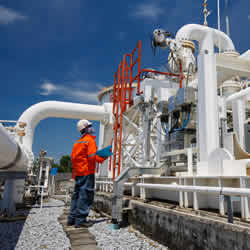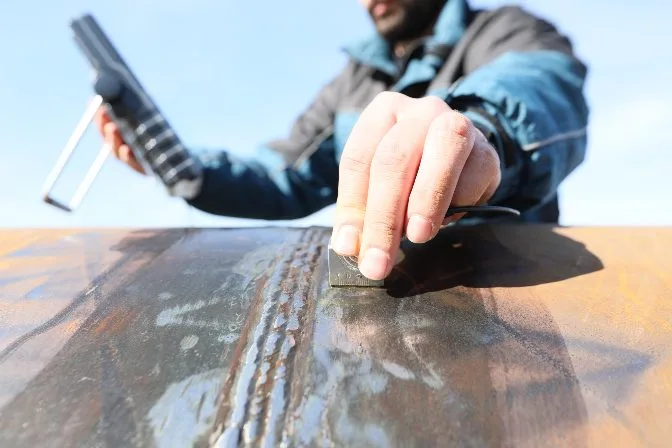Pipeline Welding Inspection: Securing Pipelines with Precision and Know-how
Pipeline Welding Inspection: Securing Pipelines with Precision and Know-how
Blog Article
Comprehensive Overview to Pipeline Welding Assessment: Guaranteeing Integrity and Safety And Security in Pipeline Building And Construction and Maintenance
The honesty and safety and security of pipes are critical in today's framework landscape, underscoring the vital function of welding evaluation in pipeline construction and upkeep. A comprehensive overview on this subject not only highlights the need of assessing weld high quality but likewise deals with the numerous inspection methods readily available, such as radiographic and ultrasonic testing. By comprehending common flaws and their ramifications, stakeholders can execute finest techniques that ensure conformity and long life. Nevertheless, the intricacies included in welding evaluation raise pertinent questions about industry standards and the advancing innovations that may redefine these methods.

Significance of Welding Examination
Welding assessment plays a critical duty in ensuring the integrity and safety and security of pipeline systems. It works as a basic process that validates the quality and integrity of bonded joints, which are typically one of the most weak spots in pipeline building and construction. Via methodical examination, examiners can determine prospective problems such as cracks, porosity, and insufficient blend, which might jeopardize the structural honesty of the pipeline.
The significance of welding inspection prolongs beyond plain conformity with market criteria; it also safeguards public wellness and the environment. Complete inspections can improve the longevity of pipe systems, reducing the demand for expensive repair services and downtime.
Along with ensuring safety and security and conformity, welding examination promotes a culture of quality assurance within companies. By focusing on examination throughout the welding procedure, business can develop an online reputation for dependability and quality, ultimately bring about raised client self-confidence and service possibilities (Pipeline Welding Inspection). Hence, the value of welding inspection can not be overstated in the context of pipe construction and upkeep
Key Welding Processes
Numerous welding processes are used in pipeline construction, each with its own benefits and applications. Among the most extensively used methods are Shielded Metal Arc Welding (SMAW), Gas Tungsten Arc Welding (GTAW), and Gas Metal Arc Welding (GMAW) SMAW is preferred for its adaptability and capacity to carry out well in different environmental problems, making it suitable for field applications.
GTAW, typically described as Tungsten Inert Gas (TIG) welding, is identified for its ability to create high-quality welds with superb control over warm input, making it ideal for thin-walled pipes and stainless-steel materials. GMAW, or Steel Inert Gas (MIG) welding, offers high deposition prices and is efficient for large-scale tasks, typically used in the manufacture of pipes in regulated environments.
In Addition, Submerged Arc Welding (SAW) is made use of for its deep infiltration and high productivity, especially in the building and construction of large-diameter pipes. Each of these processes adds to the overall stability and security of pipeline buildings, allowing welders to select the most ideal approach based upon product type, job requirements, and environmental problems. Understanding these key welding procedures is vital for efficient pipe welding inspection.
Usual Defects and Their Effect

Porosity, defined by small gas pockets entraped within the weld, compromises the product and can result in leakages. Cracks, which may happen due to thermal stresses or inappropriate cooling, can result and propagate in architectural failure under stress. Undercutting, where the base metal is eroded along the weld bead, decreases the effective cross-section of the pipeline, increasing the risk of fracture.
Incomplete combination occurs when the weld steel does not appropriately bond with the base steel, causing weak areas that might fail under stress. Slag inclusion, the entrapment of non-metallic material within the weld, can also compromise the joint's integrity. Determining and dealing with these defects early in the construction process is essential to making sure the lasting integrity and safety of pipe systems, thereby guarding both the framework and the environment.
Examination Strategies and Tools

Aesthetic examination is the first line of protection, enabling examiners to determine surface irregularities, imbalance, or other noticeable problems. Ultrasonic screening uses high-frequency acoustic waves to find inner flaws, giving accurate deepness measurements and defining problems without harming the weld. Radiographic screening uses X-rays or gamma rays to generate photos of the weld, enabling the identification of internal spaces, splits, or incorporations.
Magnetic bit testing is particularly reliable for identifying surface area and near-surface interruptions in ferromagnetic materials. This strategy involves applying an electromagnetic field and fine iron particles to the weld, revealing flaws with the build-up of fragments at problem sites.
In addition to these strategies, specialized tools such as automated ultrasonic screening tools and digital radiography systems enhance examination precision and efficiency, making certain a comprehensive analysis of pipe welds throughout construction and maintenance.
Ideal Practices for Conformity
Sticking to finest practices for compliance in pipe welding assessment is important for making certain the stability and security of the facilities. Organizations should develop a thorough quality administration system Visit Your URL that lines up with sector standards such as ASME, API, and AWS. This includes establishing detailed welding treatments that define the credentials, techniques, and materials needed for welders.
Routine training and qualification of assessment workers are vital to maintain high expertise degrees. Inspectors ought to recognize with different non-destructive screening (NDT) approaches, consisting of ultrasonic screening, radiographic testing, and aesthetic evaluation, to successfully recognize prospective problems.
Documentation plays an important role in compliance; maintaining precise records of assessments, weld treatments, and personnel credentials helps to make certain traceability and liability. Arranged audits and reviews of welding practices need to be conducted to identify locations for enhancement and ensure adherence learn this here now to developed methods.

Final Thought
Finally, the application of strenuous welding inspection protocols is paramount for making certain the honesty and safety and security of pipe building and construction and maintenance. By identifying problems and utilizing advanced examination strategies, organizations can considerably boost the quality of bonded joints. Abiding by best practices promotes compliance with sector criteria, ultimately safeguarding public wellness and avoiding environmental risks. Constant improvement in assessment procedures will contribute to the long life and dependability of pipeline systems, emphasizing the critical duty of welding inspection in the market.
The stability and safety and security of pipelines are vital in today's facilities landscape, emphasizing the crucial role of welding evaluation in pipeline building and upkeep. Recognizing these key welding procedures is important for efficient pipe welding assessment.
Adhering to finest practices for conformity in pipe he has a good point welding assessment is essential for guaranteeing the integrity and safety and security of the framework.In final thought, the application of strenuous welding examination protocols is paramount for making sure the honesty and safety of pipeline building and maintenance. Continual renovation in examination procedures will contribute to the long life and reliability of pipe systems, highlighting the crucial duty of welding assessment in the market.
Report this page